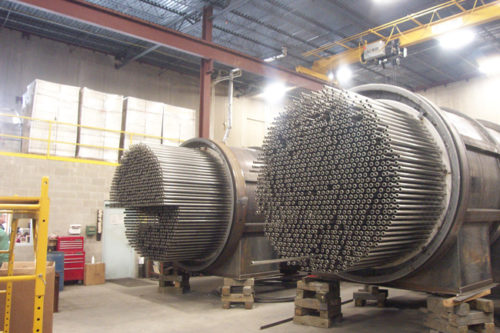How Do Shell & Tube Heat Exchangers Work?
For more than 40 years, the team at PRE-heat, Inc. has focused on high-performance industrial air-to-air heat exchangers as well as packaged heat recovery systems, with a specialization in customized builds and designs. Shell and tube heat exchangers, part of PRE-heat’s extensive product line, are available in several options to effectively carry out heat transfer. Learn more about what these heat exchangers do and how they do it.

What Is the Purpose of Shell & Tube Heat Exchangers?
Shell and tube heat exchangers recover energy from the heat of equipment like furnaces, ovens, kilns, and dryers. They also serve as primary and secondary systems for heat recovery with volatile organic compound (VOC) abatement systems or fume incinerators. In furnaces, properly functioning heat exchangers prevent unsuccessful fuel combustion, which would lead to harmful levels of carbon monoxide in the air. They’re also helpful in industries like pharmaceuticals, food and beverage, and petrochemical for offering thermal control in things like tank heaters, condensers, process coolers, and more.
Among their strengths is the fact that their design allows them to accommodate higher levels of pressure as well as extreme temperatures, particularly as compared to other varieties like plate and wheel exchangers. They also maintain reliable performance in environments that might challenge other systems, such as locations with high volumes of dust in the air. These heat exchangers are easy to clean and maintain, all while providing superior thermal transfer.
Types of Shell & Tube Heat Exchangers
It is typically simple to build various tubular heat exchanger subtypes because of the versatility of available shell, tube, and front and rear header arrangements, making these exchangers a common choice for design engineers in the process industry. Some exchanger options include:
- Fixed tube sheet exchanger. The economical structural design of this exchanger is simplistic with the tube sheet fused to its shell. This makes chemical or mechanical cleaning of the tubes possible, though the external surface of the tube is inaccessible for all except chemical cleanings.
- Free Floating Tube heat exchanger. Unlike the design of fixed tube sheet exchangers, Free Floating Tube heat exchangers are structured so that each tube within the exchanger can grow separately from the rest.
- U-tube heat exchanger. In this exchanger, the U-tube design enables limitless thermal expansion. The tube is straightened or bent into a U configuration, hence the name. The front header can have any design, but the rear header is M-shaped. Cleaning can be challenging, so these heat exchangers are ideal for tasks with tube-side fluid that’s clean. Like floating heat exchangers, U-tube heat exchangers have the option for removable bundles.
How Do Heat Exchangers Work?
Shell and tube heat exchangers are made up of a metal enclosure, or shell, acting as a pressure vessel with hollow, bundled metal tubing passing through it as part of a compact design. They work by transferring heat safely from point A to point B. To achieve this, they utilize thermal exchange and transmit warmth between two working media like liquids, gases, or a combination of both through tubes installed in the cylindrical case. The temperatures of the two materials are different than each other, and this variation is what drives the transfer of heat.
Using furnaces as an example, while burning propane fuel or natural gas, a furnace exhaust’s by-product, or its flue gas, passes through the heat exchanger. Since the flue gas is hot, it warms the metal as it moves through the system and ultimately a furnace’s exhaust outlet. While this is occurring, the metal’s heat warms the air surrounding the heat exchanger’s exterior surface. In high-efficiency furnaces, there will also be a secondary heat exchanger, in which the heat from the flue gas helps to generate water vapor which is a catalyst for greater, latent heat release. This will make the furnace more efficient.
Shell & Tube Heat Exchangers From PRE-heat
Among its many offerings, PRE-heat’s product line includes our rugged air-to-air industrial shell and tube ALT-imate heat exchanger for excessive temperatures and dirty exhaust air streams as primary and secondary heat exchangers. In vertical or horizontal options and a variety of other configurations, they have applications in furnaces, ovens, kilns, and dryers of virtually all kinds.
Our company uses square, triangular, and rotated square and triangular tube patterns, among others. With partial or full baffles, we also utilize multiple shell side flow and tube side passes. This gives our team the flexibility to custom design an exchanger for your specific space and performance needs. PRE-heat’s quality systems can withstand temperatures and air pressures of as much as 1,800° F and 25 psi, respectively.
Contact us today or request a quote to learn more about how the team at PRE-heat can develop and construct a shell and tube heat exchanger that complies with all your unique specifications.

